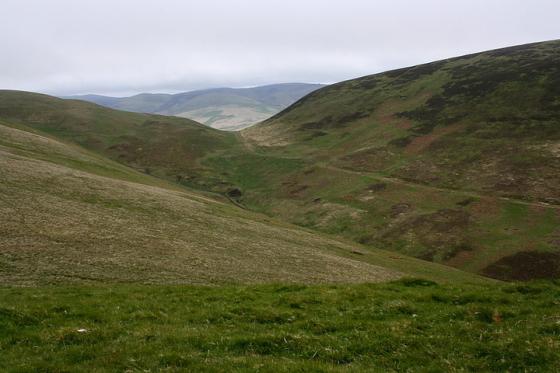I’m not one for planning holidays months in advance... perhaps it’s a somewhat childish ‘defence’ against disappointment if/when things don’t go to plan. Ha! Because there is no plan! Or simply a reaction against the sterile, packaged ‘experiences’ that seem all too prevalent these days? Nevertheless, deciding to try and visit the (apparently magnificent) Tinto cairn only the night before commencing this year’s Scottish tour is perhaps taking the policy – such as it is – to extremes. But there you are. Anyway, I arrive at the large car park at Fallburn around mid-day, the pristine blue skies of early morning Essex long since replaced by the far more hostile South Lanarkshire version.
Neither the objective, nor route are in question at the outset, a well-worn track snaking away up the hillside to the approx SW towards the prominent skyline cairn, via Totherin Hill. The optical effects of fore-shortening, not to mention the company of a number of other local Saturday walkers, reduce the impact of what is, after all, going to be an ascent of a 2,320ft mountain in less than ideal conditions. To be fair, it’s not the most difficult climb, although, ironically, I make very heavy weather of it due to a combination of lack of sleep and a ‘stitch’ which just won’t go away. The dodgy shoulder again. Then there’s the wind.... which suddenly makes itself felt as I leave the lee of the mountain above Maurice’s Cleuch. Suffice to say I’m glad I can delve into the rucksack to retrieve full kit and not simply apply a ‘hoodie’ like others. But then I’m not a tough local, but a soft Sassenach. So, a final struggle, and there it is. From what I understand, Scotland’s largest upland cairn.
I don’t think I will ever be able to adequately relate why these mountain round cairns – after all no more than large piles of stones – affect me to such an extent. Perhaps it’s the recognition of the sheer effort they must have taken to erect? Or possibly they unlock some long suppressed folk memories, remnants of which survive in the infuriating ‘need’ for some to add to their fabric today? Or are they simply physical representations of that ‘on top of the world’ feeling of dominance most social animals seem to seek? Or just the connection with the elements, both on the physical (wind, rain... hey, even sun)and metaphysical levels (appreciation of views)? Or is it simply that they were erected by people so long ago, yet still remain to provide a link to them, no matter how tenuous?
Whatever the truth – assuming there is a truth – all of the above applies to the great Tinto cairn to arguably a greater extent than most – possibly all – of the other such monuments I’ve visited in these Isles. It is simply massive! Gigantic. Truly astonishing. I climb to the summit of the massive stone pile.... alone.... since a sudden, violent squall accompanied by a mantle of mist sends the other summit visitors heading for their cars, soaked from head to foot. Ha! How dare you call me a mere hill..... However the swirling cloud disperses and the vistas are once again exquisite... yeah. I’m convinced it is the outlook which was the primary factor in the siting of these monuments. The cairn marks the spot.... some spot, some cairn. Methinks extreme locations generate extreme emotions.
Unfortunately the cairn has not been well treated. Litter is all too sadly in evidence, not to mention a pathetic attempt at a ‘storm shelter’, with remnants of some circular, stone pillar to the south. However Tinto cairn is simply so overwhelming in stature that these merely scratch the surface, so to speak. I stay for c4 hours, gobsmacked by the magnitude of this mountain top monument, only to spot what appears to be a multi-vallate hillfort beside the track upon the final descent. It is too much. How I missed the Fallburn enclosure on the way up, I’ll never know. Some first day.




















































